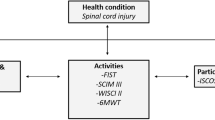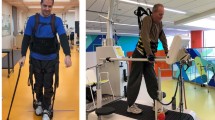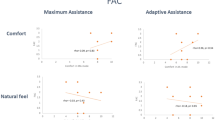Abstract
Study design: Clinical study on six spinal cord-injured subjects. The performance of two automatic gait-pattern adaptation algorithms for automated treadmill training rehabilitation of locomotion (called DJATA1 and DJATA2) was tested and compared in this study.
Objectives: To test the performance of the two algorithms and to evaluate the corresponding patient satisfaction. We also wanted to evaluate the motivation of the patients to train with a fixed gait pattern versus training where they can influence and change the gait pattern (gait-pattern adaptation).
Setting: Spinal Cord Injury Center Paracare, Balgrist, Zürich, Switzerland.
Methods: The experimental data were collected during six blinded and randomized training trials (comprising three different conditions per algorithm) split into two training sessions per patient. During the experiments, we have recorded the time courses of the six parameters describing the adaptation. Additionally, a special patient questionnaire was developed that allowed us to collect data regarding the quality, perception, speed, and required effort of the adaptation, as well as patients’ opinion that addressed their motivation. The achieved adaptation was evaluated based on the time course of adaptation parameters and based on the patient questionnaire. A statistical analysis was made in order to quantify the data and to compare the two algorithms.
Results: Significant adaptation of the gait pattern took place. The patients were in most cases able to change the gait pattern to a desired one and have always perceived the adaptation. No statistically significant differences were found between the performances of the two algorithms based on the evaluated data. However, DJATA2 achieved better adaptation scores. All patients preferred treadmill training with gait-pattern adaptation.
Conclusion: In the future, the patients would like to train with gait-pattern adaptation. Besides the subjective opinion indicating the choice of this training modality, gait-pattern adaptation also might lead to additional improvement of the rehabilitation of locomotion as it increases and promotes active training.
Sponsorship: The work was supported by The Swiss Commission for Technology and Innovation (Project No. 4005.1).
Similar content being viewed by others
Log in or create a free account to read this content
Gain free access to this article, as well as selected content from this journal and more on nature.com
or
References
Barbeau H, Rossignol S . Recovery of locomotion after chronic spinalization in the adult cat. Brain Res 1987; 412: 84–95.
Rossignol S . Locomotion and its recovery after spinal injury. Curr Opin Neurobiol 2000; 10: 708–716.
Dietz V, Colombo G, Jensen L, Baumgartner L . Locomotor capacity of spinal cord in paraplegic patients. Ann Neurol 1995; 37: 574–582.
Wernig A, Müller S, Nanassy A, Cagol E . Laufband therapy based on ‘Rules of Spinal Locomotion’ is effective in spinal cord injured persons. Eur J Neurosci 1995; 7: 823–829.
Hesse S et al. Treadmill training with partial body weight support compared with physiotherapy in nonambulatory hemiparetic patients. Stroke 1995; 26: 976–981.
Barbeau H, Ladouceur M, Norman KE, Pepin A . Walking after spinal cord injury: evaluation, treatment, and functional recovery. Arch Phys Med Rehabil 1999; 80: 225–235.
Dietz V, Colombo G, Jensen L . Locomotor activity in spinal man. Lancet 1994; 344: 1260–1263.
Grillner S . Control of locomotion in bipeds, tetrapods, and fish. In: Motor Control Handbook of Physiology Vol. 2(2) Brooks V (ed). American Physiological Society: Bethesda 1981, 1179–1236.
Grillner S . Neurobiological bases of rhytmic motor acts in vertebrates. Science 1985; 228: 143–149.
Colombo G, Joerg M, Schreier R, Dietz V . Treadmill training of paraplegic patients with a robotic orthosis. J Rehabil Res Dev 2000; 37: 693–700.
Jezernik S, Colombo G, Morari M . Automatic gait-pattern adaptation algorithms for rehabilitation with a 4 DOF robotic orthosis. IEEE Trans Robot Automat 2004, accepted for publication in 2004.
Jezernik S, Jezernik K, Morari M . Impedance control based gait-pattern adaptation for a robotic rehabilitation device. In: Proceedings of the Second IFAC Conference on Mechatronic Systems, Berkeley, USA December 2002, 417–421.
Jezernik S, Morari M . Controlling the human–robot Interaction for Robotic Rehabilitation of Locomotion. In: Proceedings of the Seventh International Workshop on Advanced Motion Control (AMC2002), Maribor, Slovenia, July 2002, 133–135.
Jezernik S et al. Robotic orthosis Lokomat: a rehabilitation and research tool. Neuromodulation 2003; 6: 108–115.
Author information
Authors and Affiliations
Rights and permissions
About this article
Cite this article
Jezernik, S., Schärer, R., Colombo, G. et al. Adaptive robotic rehabilitation of locomotion: a clinical study in spinally injured individuals. Spinal Cord 41, 657–666 (2003). https://doi.org/10.1038/sj.sc.3101518
Published:
Issue date:
DOI: https://doi.org/10.1038/sj.sc.3101518
Keywords
This article is cited by
-
The efficacy of gait rehabilitations for the treatment of incomplete spinal cord injury: a systematic review and network meta-analysis
Journal of Orthopaedic Surgery and Research (2023)
-
Effect of EMG-biofeedback robotic-assisted body weight supported treadmill training on walking ability and cardiopulmonary function on people with subacute spinal cord injuries – a randomized controlled trial
BMC Neurology (2019)
-
Selective control of gait subtasks in robotic gait training: foot clearance support in stroke survivors with a powered exoskeleton
Journal of NeuroEngineering and Rehabilitation (2013)
-
Locomotor training using a robotic device in patients with subacute spinal cord injury
Spinal Cord (2011)



